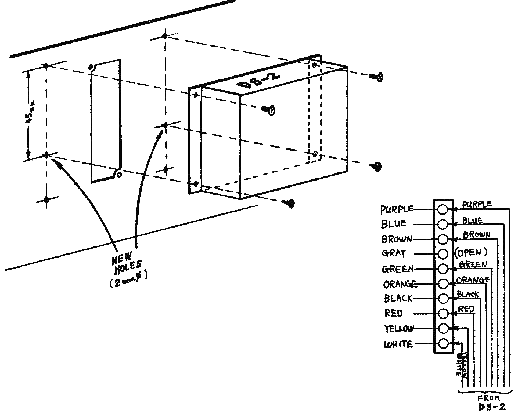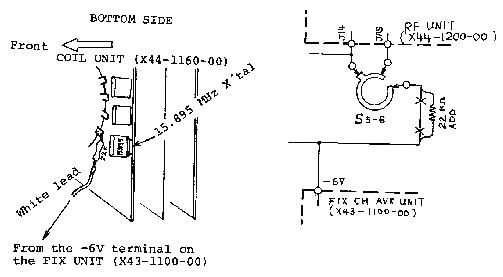

In the TS-520SE, the Heater Switch has been replaced with a CW WIDE/NARROW
select switch. For those operators who desire this type feture for their
transceiver, the following information may be considered as a
guideline.
TS-520S series transceivers
A. FIX CH C terminal to IF SSB Terminal
B. FIX CH 4 terminal to IF CW terminal
Placing the FIX CH switch to 4 will operate the SSB filter
in CW mode.

A. Under; IC2,4,13,20-25,34, 1 each
Total 10
B. Adjacent or between; IC3,13-14,15-16,22-23 1 1 each
IC1-2,6,18 2 each
IC12 3 each
Total 13
C. Located between rows: IC13-18,20-25 - 5
20-25, 26-31 - 10
IC26-31, 32-37 - 15
IC32-37, 38-39 - 25
Total 55
D. At rear panel: FS7805 regulator - 1
2SD235 transistor- 3
Total 4
E. Display unit - 2
Additional Ponts
Transmitter

When troubleshooting a TS-520S, check all power supply voltages, including the -6v DC supply. Symptoms such as dead, blown 2A DC fuse and now dead, low RX, no TX, or similar may occur after switching between 80 and 40M.
Cause of failure may be traced to an intermittent shorting between the 14v dc
and -6 dc supplies as the band switch is rotated between 40 and 80 meters. This
will weaken or destroy D8, a 6v zener on the FIX CH AVR unit.
To prevent
repeat failures, break the White lead and install a 22 K ohm 1/2 watt resistor
at the bandswitch S5-6, between the -6v supply line and switch terminal. An of
course replace D8 on the FIX CH AVR unit, X43-1100-00.
New Part: 22 k ohm 1/2 W carbon resistor
Please notate your Service Manual.


Reports of intermittent frequency shift during CW operation, on the order of a few hundred cycles, may be traced directly to the Carrier Unit.
On the Carrier unit X50-0009-01, install a ground lead of #18 tinned wire or
similar, between the cases of T1 transformer and X3, the LSB XTAL.
Recheck
frequencies after installing this ground lead.
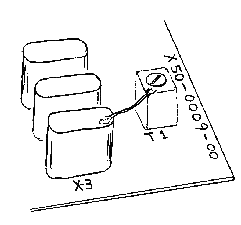
Please notate your service manual. 
19-07-1998 TS-520 Increased sensitivity,
Better audio and Amplitude Modulation
1. Increased
sensitivity.
On the RF board, Q5 is the RF RX amp. Notice that G2 is tied
to the AGC line.
Bend G2 up from the socket, solder a 10k resistor to it and
connect the other end of the resistor to the 9v line on the front of the board.
This will allow the FET to run wide open, and you will have a better S/N ratio.
You will gain about two S units in signal and you may want to adjust your S
meter to compensate. I did this mod almost a year ago and have had no problems
even with signals that were 40db over!
2. Better audio.
A few
capacitors should be changed to accept a wider audio bandwidth.
These will
only increase the BASS response and not the treble as it is limited by the IF
filter. Change the following on the generator board;
C3 (1µF) to
10µF
C4 (4.7µF) to 47µF
C5 (1µF) to 4.7µF
C8 (.047µF) to 4.7µF
C9
(1µF) to 10µF
C11 (4.7µF) to 47µF
C10 (10µF) to 22µF
This will make
the Tx audio flat. Make sure that the Local Oscilator is adjusted correctly or
else you will have the bass attenuated by the IF SSB filter.
I also
changed the caps on the AF board.
C14 (.47µF) to 4.7µF
C13 (.047µF) to
.47µF
C1 (1µF) to 4.7µF
You will also want to use a good speaker. I
have an old speaker box that got gutted.
I put in a 6x9 coaxial car speaker
and it sounds great! Since the audio is limited to 4Khz anyway, don't go bonkers
with tweeters. You may want to play with a few caps inside the speaker to roll
off some of the very highs which will only be transistor noise
anyway.
Along with changing the caps for flat audio, I installed two
jacks for audio on the back of the 520. These are RCA female jacks that are used
to connect to an equalizer.
Unwrap the wire on the generator board marked MA
O. This is the output of the Microphone Amplifier. Connect some microphone coax
from this terminal to your RCA socket on the back of the rig marked output.
Remember to ground both ends of the cable so you won't have hum/RF problems. Now
connect the other RCA socket via mic cable to the wire that you unwrapped from
the MA O post.
Make up a jumper cable for those times you don't want to use
the EQ.
I recommend an old Radio Shack 5 band EQ. I have no RF problems at
all and I run 500w PEP with the amplifier sitting next to the Kenwood. Stay
awayf from EQ's that use all IC's. I find regular transistors are better for
handling RF.
3. Amplitude Modulation
This radio can talk AM in a
pinch. You will be limited to SSB reception though. That's OK if you don't mind
playing with the RIT to get rid of the beat tones.
I decided it was degrading
the specs when I put in a regular AM detector so I pulled it out. Here is how
you make it talk.
Get a DPDT relay (12v) and connect it inline with the fixed
channel selector switch, so that when you select crystal 4 the relay
energizes.
Now lets take the relay in two sections. The first is connecting
the ouptut of the mic amp into a matching transformer via this relay. You want
it connected so that the MA O is on the wiper and the relay NC1 is connected to
the Balanced Modulator. Connect the other relay terminal NO1 to the low
impedance side of the transformer. Connect the other lead of this winding to
ground. So when you select fix channel 4, the relay energizes, and disconnects
the mic from the balanced modulator and connectes it through the transformer to
ground.
Ok now the second part of the AM mod.
Take the HIGH impedance
winding of the transformer and connect one leg to ground. Take the other leg and
connect it to a 47uF cap.(neg lead) Connect the positive side of the cap to an
820 ohm resistor.
Connect the resistor to the 9v terminal (on the RF board or
most any other board) Connect the junction of the resistor/capacitor to the NO2
terminal of the relay.
Connect the wiper of the relay to S on Q3 on the RF
board. I found R17 to have its exposed wire connected to S on Q3. Simply scratch
the paint away on R17 and solder to the resistor.
Since this design
modulates after the IF, you will have full fidelity and bandwidth of your audio.
If you use an EQ, don't be excessive with the highs or you will have enemys from
the splash you create. Also, there is no limiter here. If you have access to
one, install it in the EQ loop.
Have fun on 80M!!
73's
For
more info or if you have questions;
Greg Weremey - Electronic Service Pros.
www.angelfire.com/ma/electroservepro
Be sure to check
out the D-104 modification page and listen to the audio
demonstration!
05-04-1999 Kenwood TS-520S for
QRP
The TS-520S can be operated QRP down to a few milliwatts with
simple modification. Apply negative voltage on the ALC pin of the ancillary
socket.
Modification consists of a 220K Ohm pot and a 9V battery.


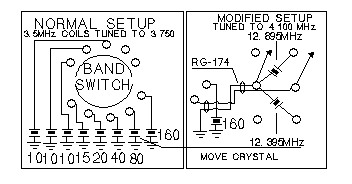


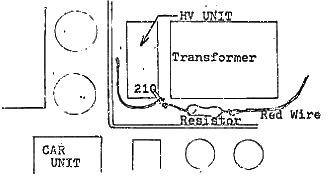


We have found a few instances of customers who live near an AM broadcast station hearing that station on the 3.5 MHz band of theire TS-520. Shown below is a filter that may be installed if this occurs.
 |
|
A Suggested located for the filter is on a small terminal strip that is then
mounted on a mounting screw of the RF unit. This screw is located at the front
corner next to the VFO. The cable between S-9 (WWV switch) and terminal NAT of
the RF unit is removed from terminal NAT and connected to one side of the
filter. A short piece of RG-174/U is then connected from the other side of the
filter to the terminal NAT. This hould prevent the AM broadcast interference.

20-02-2000
TS-520/520S BS-5 Sweep interference
Author: Trio-Kenwood Communication,
inc.
BS-5 users may report ignition-like interference on 80 & 40 M from their SM-220 with BS-5. Noise will be heard between 3850-3870 KHz, and 7245-7260 KHz any time the scope is on.
The sweep signal mixes with the IF (carrier) frequency. This derived signal, or its second harmonic will usually be less than an S1 signal, unless the coax ground to the scope is opened, in which case S9 may be indicated.
On the SM-220 PCB X65-1240-00, change the BS-5 +11V DC supply point:

Please notate your Service Manual: SM220, TS-520 &
TS-520S
18-03-2000 Adding IF output to the TS-520
and TS-520S tranceivers for use with th SM-220
Author: Trio-Kenwood Communication,
inc.
The TS-520 and TS-520S transceivers do not provide an IF output signal. It is
necessary to have this if you want to look at a specific received signal on the
SM-220 station monitor. The best place to pick up this signal is at the tuned
output of Q4 on the IF unit (X48-1060-00).
A 22 pF capacitor should be used
for coupling and a 10 Kohm resistor for impedance matching. This is shown in the
schematic below. The center conductor of a 39 cm (14") length of 50 ohm
(RG-174/U or similar) cable is connected to the pick-up at one end and to pin 7
of the REMOTE socket and the ground path of the IF Unit. A 75 cm (30") 50 ohm
cable should be made up with one end connected to pins 7 and 1 of the 8 pin plug
supplied with the transceiver and BNC connector on the other end. The BNC
connector will be plugged into the vertical input jack on the front of the
SM-220.
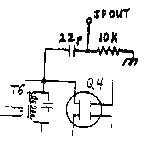

The DS-1A DC-DC converter for the TS-820 series and TS-520/S has been replaced by a new model, the DS-2. Wiring color code is the same. Physical size is smaller. Two additional mounting holes must be drilled in the transceiver rear panel.
